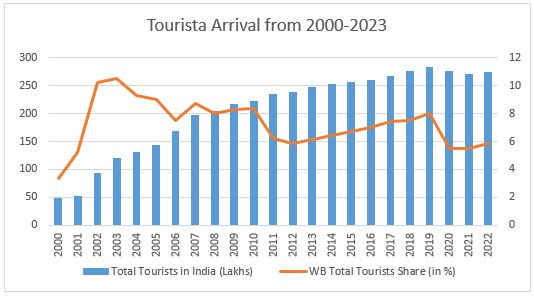Global Growth Synergies of Tourism & West Bengal Perspective
DOI:
https://doi.org/10.5281/zenodo.15852494Keywords:
employment, foreign & domestic tourists arrival, gdpAbstract
Tourism has substantial involvement in maintainable development, economic advancement and social assistances. It is an economic activity which will boost up when a person leaves his residence for a span of time for cherishing the nature, seep the hidden treasure and to grab the energy and oxygen. If we analyse the statistics published from the last decade it has been seen that tourism has become a major shove area in India to address the aforesaid issues, to utilize the limited resources and also to optimize the level of financial involvement for developing tourist substructure in a restraint economic sphere. This article verbalizes a simple practise to enumerate tourism potential for the state. This paper attempts to explore direct effects on the social, cultural, educational and economic sectors of national societies and on their international relations such as tourism can help to enhance economic activities and exploits local cultural and natural specialties in a positive way. India can take initiative to proper utilization of skilled and semi-skilled workers to provide employment opportunities to the destinations of tourism according to the suggestions given by the Planning Commission. This paper used secondary data for analysing the growth of West Bengal. According to the estimate given by the World Travel and Tourism Council, this sector now generate more than 4% of the country's GDP and more than 20 crore jobs. As a whole, Tourism is expected to generate 23 billion of economic activity now and by 2034 it is expected to grow to $ 45.08 billion. Among the different regions of the country, North India attracts the highest number of tourists. As a whole, 49% of foreign tourists throng to this part of the country while Western India attracts 29% of them. With 18 % of foreign tourist, South India remains in the third spot while Eastern region has a very negligible share of only 4 % of foreign tourists.
Downloads
References
Al Mamun, A., & Mitra, S. (2012). A methodology for assessing tourism potential: Case study Murshidabad District, West Bengal, India. International Journal of Scientific and Research Publications, 2(9), 1-8.
Chakrabarty, P., & Mandal, T. Religious tourism and environment: A geographical study in the satipiths of Birbhum district, West Bengal.
Sharma, M. S., Das, M. S., Ray, N., & Patra, M. N. environmental impact of cultural tourism on host community: evidence from West Bengal. Emerging Business Environment, 239.
Mukherjee, M. T., Chakraborty, M., & Ray, N. A study on pilgrim tourism: Evidence from kamakhya, Assam. Digital Transformation in Emerging Business Environment, 250.
Batabyal, D., Halam, H., Sen, S. K., Chakma, M. K., Sinha, R., & Selem, K. M. (2023). Circuit development approach to geotourism and geoparks in Northeast India. GeoJournal, 88(6), 6161-6173.
Bezborah, C. J. exploring the impact of sustainable practices on the preservation of cultural heritage sites in Assam’s tourism industry.
Thankachan, M., & Sheeba, C. Tantric traditions of the Sakta cult: Re-examining ritual practices of Kamakhya temple in Indira Goswami’s novel The Man from Chinnamasta.
Shinde, K. A., & Olsen, D. H. (2022). Reframing the intersections of pilgrimage, religious tourism, and sustainability. Sustainability, 15(1), 461.
Sofique, M. A., & Rani, R. Problems and prospects of rural tourism in bakreshwar and nearby tourist sites in birbhum, West Bengal, India-with reference to the typology of tourists in the region.
Batabyal, D., Rawal, Y. S., Chatterjee, P., & Goswami, S. (2023). Temple service quality model for future pilgrimages in Indian sub-continent through user-generated contents (UGC) in TripAdvisor. International Journal of Tourism Anthropology, 9(2), 113-135.

Published
How to Cite
Issue
Section
License
Copyright (c) 2025 Tama Dwibedi

This work is licensed under a Creative Commons Attribution 4.0 International License.
Research Articles in 'Management Journal for Advanced Research' are Open Access articles published under the Creative Commons CC BY License Creative Commons Attribution 4.0 International License http://creativecommons.org/licenses/by/4.0/. This license allows you to share – copy and redistribute the material in any medium or format. Adapt – remix, transform, and build upon the material for any purpose, even commercially.









